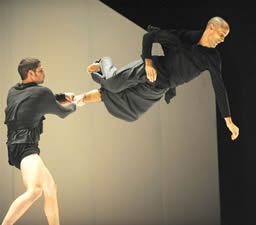Two magnificent string quartets were dramatically and artistically presented by the Reynolda Quartet Sunday afternoon in the lively hall at the Reynolda House Museum of American Art. On the program were Quartet in C minor, Op. 59, No. 1 by Johannes Brahms (Germany, 1833-97) and Quartet No. 6 by Béla Bartók (Hungary, 1881-1945).
Brooks Whitehouse, cellist of the Reynolda Quartet, provided an overview of what the “In the Footsteps of a Giant” program would be to the large and appreciative audience that gathered for an afternoon of chamber music. The giant was Beethoven, who set the standard for writing string quartets for all subsequent composers. The cellist quoted the famous Brahms’ statement, “you can’t imagine what it is like to hear such a giant’s footsteps constantly behind one.”
Indeed, it wasn’t until Brahms was 40 before he finally felt confident enough to write his first quartet in 1873. Whitehouse went on to give some historical background about Bartók’s quartet writing in general, which followed Beethoven’s innovations. Bartók’s last quartet was written during intense times: the rise of Fascism in Hungary and his mother’s death in 1939.
The Reynolda Quartet is comprised of Ida Bieler and Janet Orenstein (violins), Ulrich Eichenauer (viola), and Whitehouse; all are faculty artists at the University of North Carolina School of the Arts. They opened the concert with the Bartók, which begins with a melancholic viola solo, intensely presented by Eichenauer. All four movements have the tempo marking “Mesto” (sad), and this opening passage serves as a binding force (the motto) throughout. This is a thorny work, for both the listener and the players. But one could not imagine a more convincing performance than this one.
This “tune” is shared at some point by all four musicians in the course of the opening movement. An amazing number of textures are explored here (and throughout the four movements) including hearty unisons and four-part independent lines, which the Reynolda players gave life to.
The second movement March opened with soulful solo playing by Whitehouse, accompanied by the others. One of the wonderful things about Reynolda’s playing is that each member is sensitive to who has the main theme and allows for that player to stand out. The central portion of the movement is a fast Hungarian dance; occasional tonal passages sounded almost humorous in this context.
The third movement opens with the motto, now in the violin. Bieler’s poignant playing brought back the pathos of the first movement. A sardonic Burletta (little joke) occupies the central section before the opening returns. A surprising ending includes all sorts of pizzicatos and slides, played with utmost precision by the musicians.
The finale is almost entirely based on the motto theme, concluding with about as bleak an ending as one can imagine. All of the depth, excitement, power, and sadness were vividly brought out in this terrific reading.
What a different creature the Brahms quartet is! The two outer movements are full of fiery passion, balanced by gentle lyricism. Deeply romantic and fervid, drama is at the forefront. Whitehouse accurately described the first movement as having an “anxious outlook.”
The second movement Romance, which Whitehouse described as a lullaby, is stunningly beautiful, and the musicians played it just so, tender and heartfelt. The third movement Allegretto opens with a feeling of restlessness, tinged with sadness. A gentler section, exquisitely performed, provides some respite as does another more upbeat section.
The finale returns the nervous character of the opening. The surging, pulsating outbursts were dramatically presented. The Reynolda’s confident playing of the concluding measures rushed to the unavoidable heartrending end.
Intonation throughout was spot-on, and ensemble couldn’t have been better. The energy and commitment of all four superb musicians was appreciated by the enthusiastic crowd.











